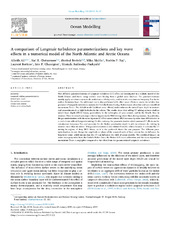| dc.contributor.author | Ali, Alfatih | |
| dc.contributor.author | Christensen, Kai Håkon | |
| dc.contributor.author | Breivik, Øyvind | |
| dc.contributor.author | Bertino, Laurent | |
| dc.contributor.author | Malila, Mika Petteri | |
| dc.contributor.author | Raj, Roshin Pappukutty | |
| dc.contributor.author | Chassignet, Eric P. | |
| dc.contributor.author | Bakhoday Paskyabi, Mostafa | |
| dc.date.accessioned | 2020-07-01T08:48:16Z | |
| dc.date.available | 2020-07-01T08:48:16Z | |
| dc.date.issued | 2019 | |
| dc.Published | Ali AMA, Christensen KH, Breivik Ø, Bertino L, Malila MP, Raj RR, Chassignet EP, Bakhoday Paskyabi M. A comparison of Langmuir turbulence parameterizations and key wave effects in a numerical model of the North Atlantic and Arctic Oceans. Ocean Modelling. 2019;137:76-97 | eng |
| dc.identifier.issn | 1463-5011 | en_US |
| dc.identifier.issn | 1463-5003 | en_US |
| dc.identifier.uri | https://hdl.handle.net/1956/23158 | |
| dc.description.abstract | Five different parameterizations of Langmuir turbulence (LT) effect are investigated in a realistic model of the North Atlantic and Arctic using realistic wave forcing from a global wave hindcast. The parameterizations mainly apply an enhancement to the turbulence velocity scale, and/or to the entrainment buoyancy flux in the surface boundary layer. An additional run is also performed with other wave effects to assess the relative importance of Langmuir turbulence, namely the Coriolis-Stokes forcing, Stokes tracer advection and wave-modified momentum fluxes. The default model (without wave effects) underestimates the mixed layer depth in summer and overestimates it at high latitudes in the winter. The results show that adding LT mixing reduces shallow mixed layer depth (MLD) biases, particularly in the subtropics all year-around, and in the Nordic Seas in summer. There is overall a stronger relative impact on the MLD during winter than during summer. In particular, the parameterization with the most vigorous LT effect causes winter MLD increases by more than 50% relative to a control run without Langmuir mixing. On the contrary, the parameterization which assumes LT effects on the entrainment buoyancy flux and accounts for the Stokes penetration depth is able to enhance the mixing in summer more than in winter. This parameterization is also distinct from the others because it restrains the LT mixing in regions of deep MLD biases, so it is the preferred choice for our purpose. The different parameterizations do not change the amplitude or phase of the seasonal cycle of heat content but do influence its long-term trend, which means that the LT can influence the drift of ocean models. The combined impact on water mass properties from the Coriolis-Stokes force, the Stokes drift tracer advection, and the wave-dependent momentum fluxes is negligible compared to the effect from the parameterized Langmuir turbulence. | en_US |
| dc.language.iso | eng | eng |
| dc.publisher | Elsevier | en_US |
| dc.rights | Attribution CC BY | eng |
| dc.rights.uri | http://creativecommons.org/licenses/by/4.0 | eng |
| dc.title | A comparison of Langmuir turbulence parameterizations and key wave effects in a numerical model of the North Atlantic and Arctic Oceans | en_US |
| dc.type | Peer reviewed | |
| dc.type | Journal article | |
| dc.date.updated | 2020-01-13T15:34:09Z | |
| dc.description.version | publishedVersion | en_US |
| dc.rights.holder | Copyright 2019 The Author(s) | en_US |
| dc.identifier.doi | https://doi.org/10.1016/j.ocemod.2019.02.005 | |
| dc.identifier.cristin | 1704909 | |
| dc.source.journal | Ocean Modelling | |
| dc.relation.project | Notur/NorStore: NN9481k | |
| dc.relation.project | Notur/NorStore: NS9481k | |
| dc.relation.project | Norges forskningsråd: 237906 (CIRFA) | |
| dc.relation.project | Norges forskningsråd: 244262 (RETROSPECT) | |
| dc.relation.project | Copernicus-programmet: CMEMS ARC-MFC | |
| dc.relation.project | Copernicus-programmet: CMEMS WaveFlow | |
| dc.relation.project | Notur/NorStore: NS9481K | |
| dc.relation.project | Notur/NorStore: NN9481K | |
| dc.relation.project | Copernicus-programmet: CMEMS WAVEFLOW | |

